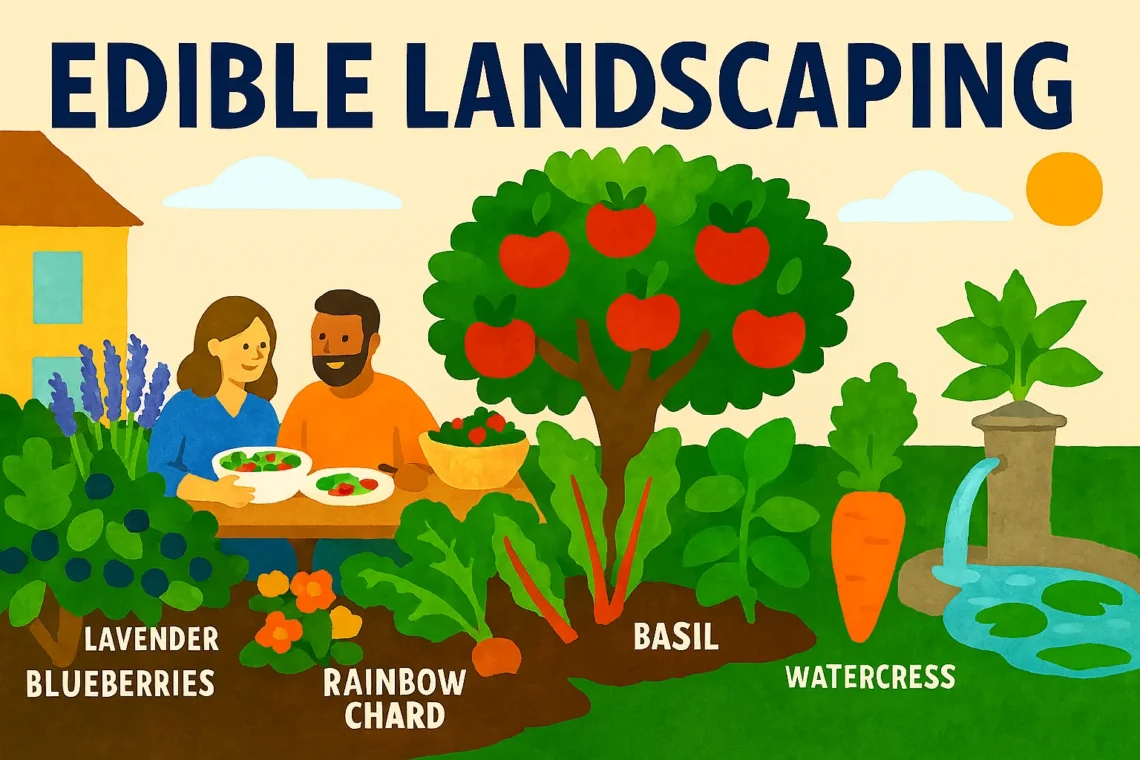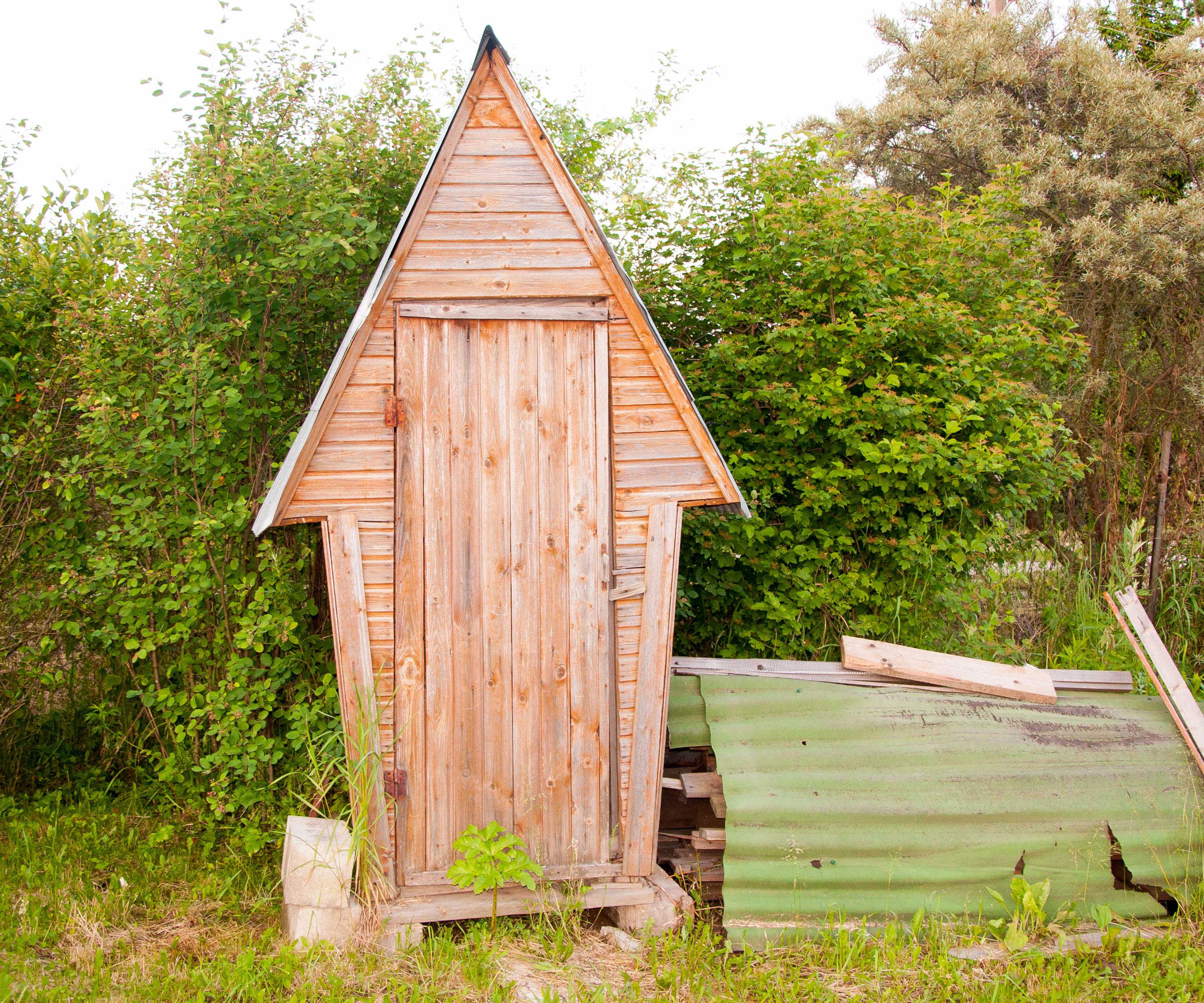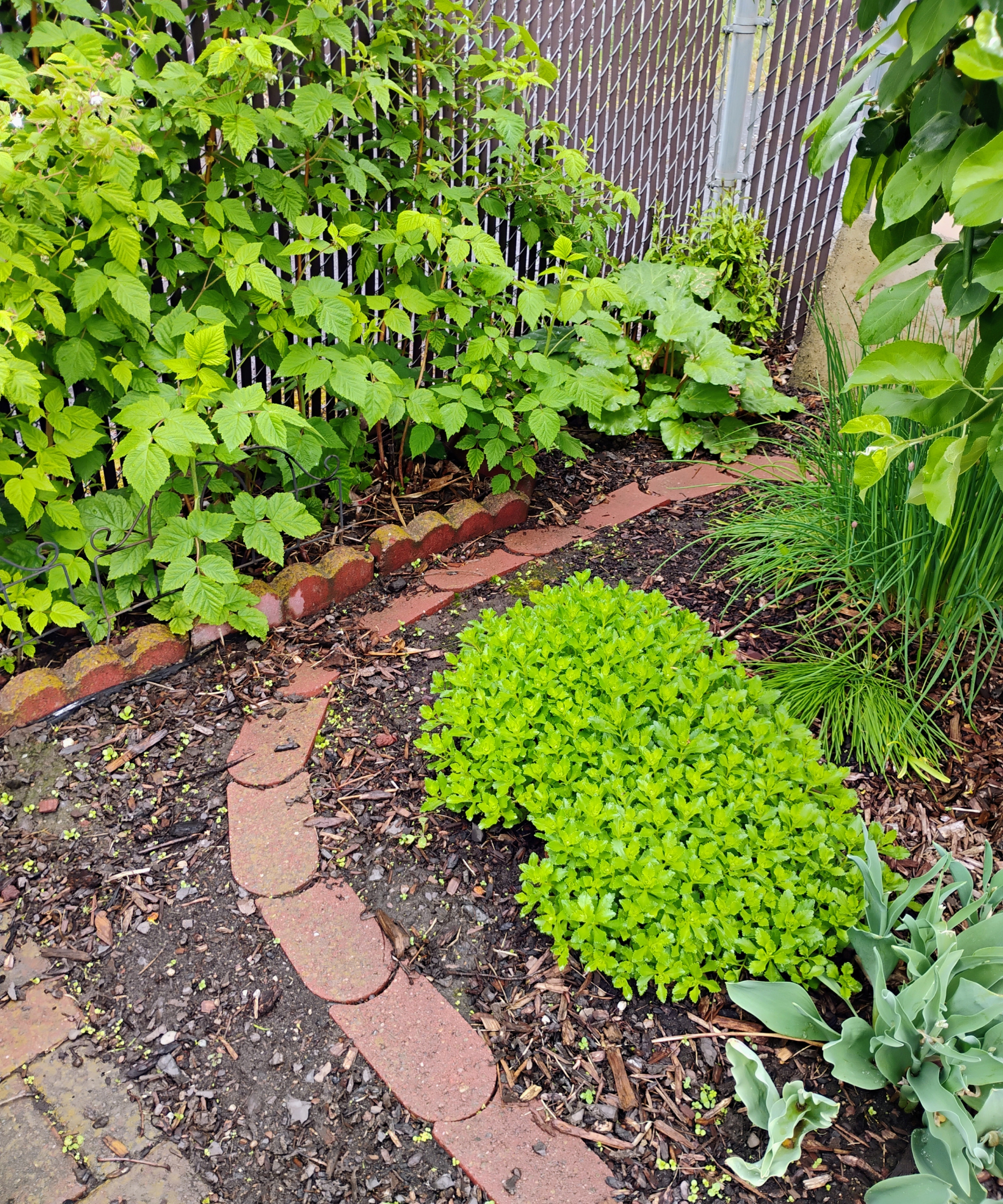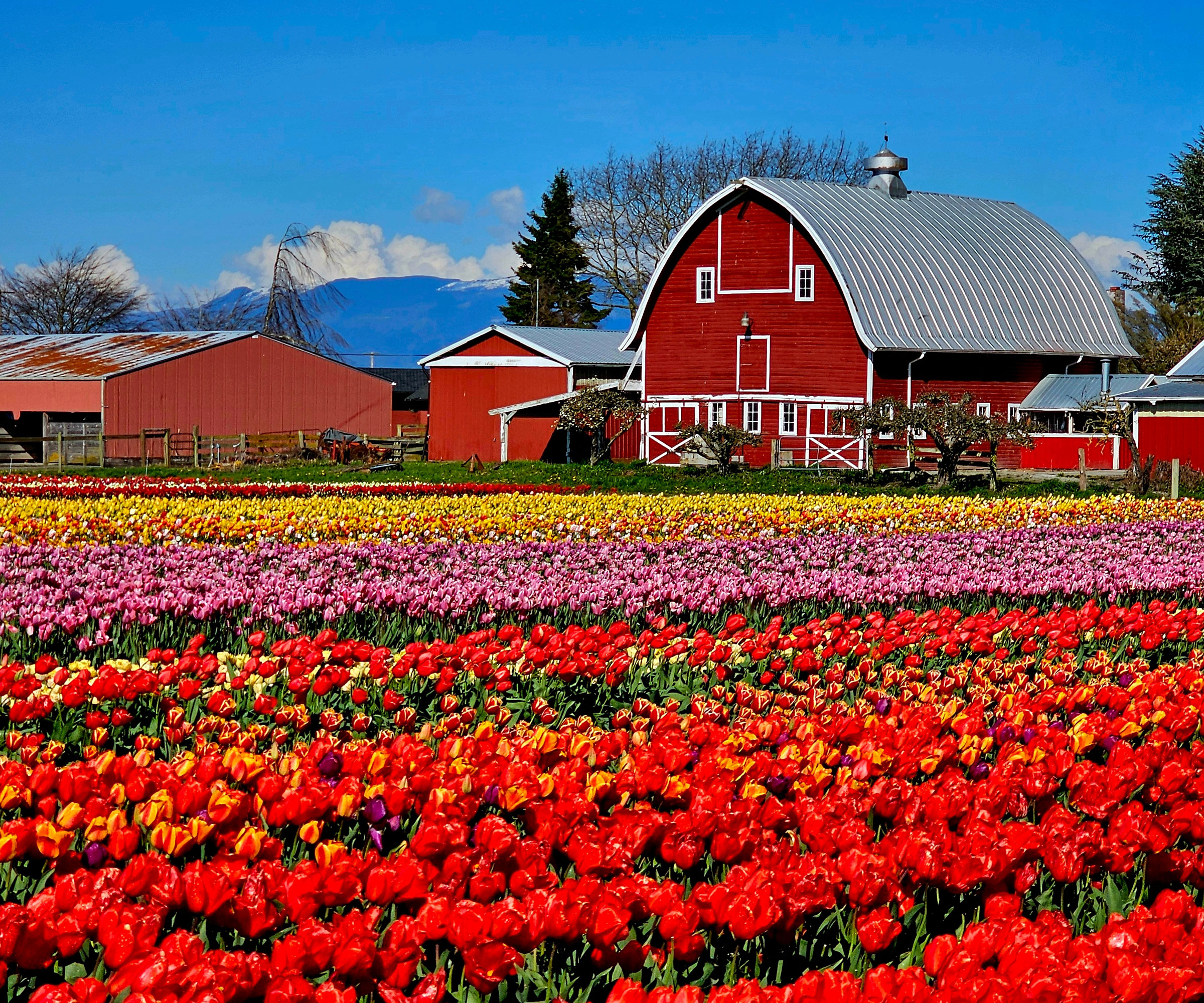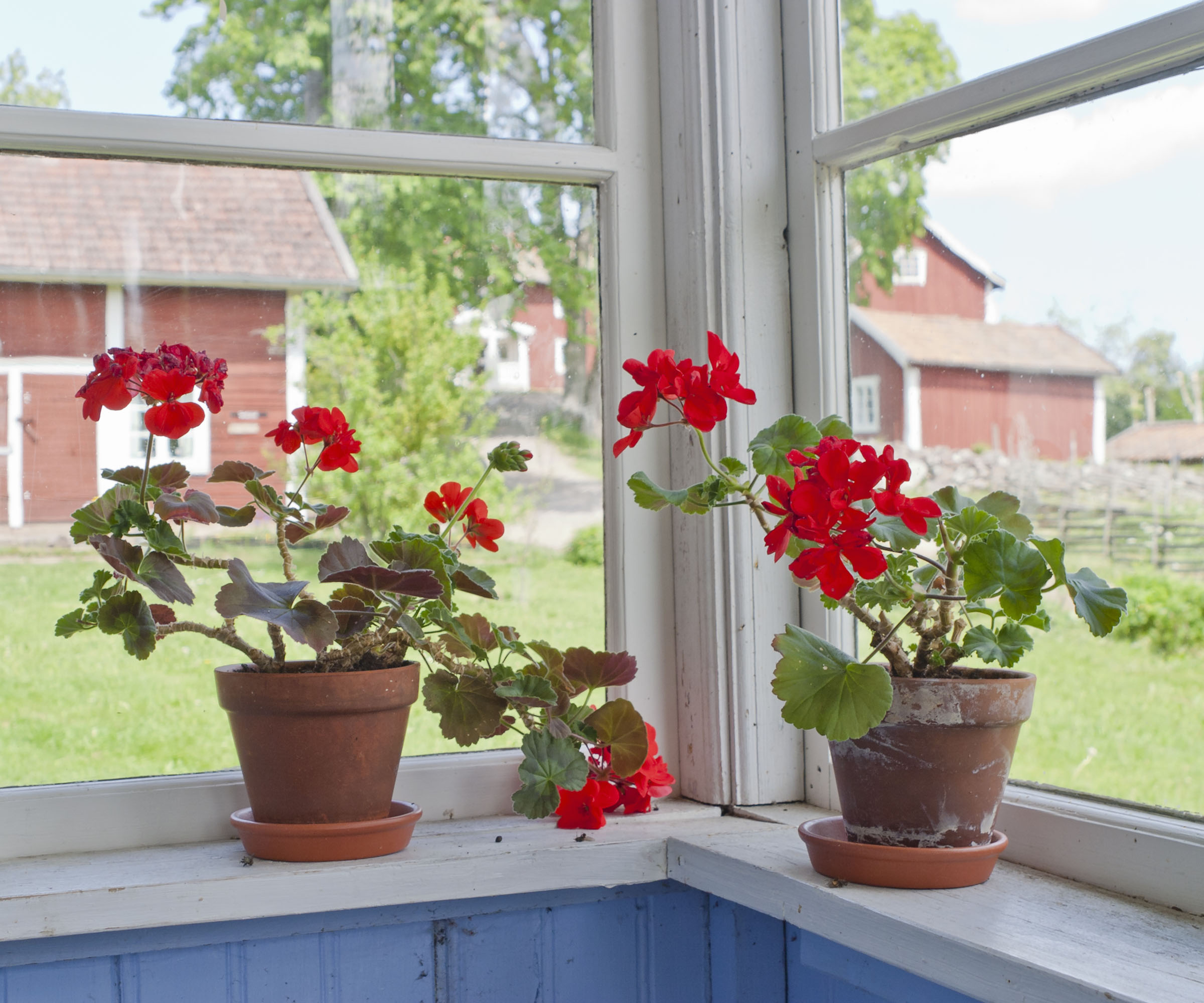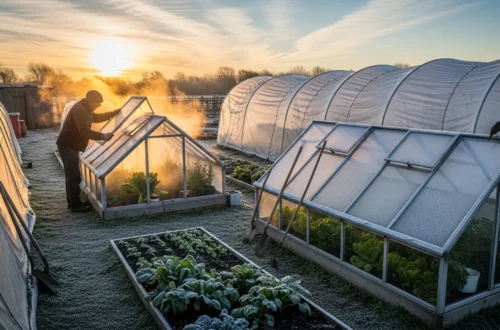Table of Contents
Introduction: Why Settle for Just Pretty When You Can Have Pretty and Productive?
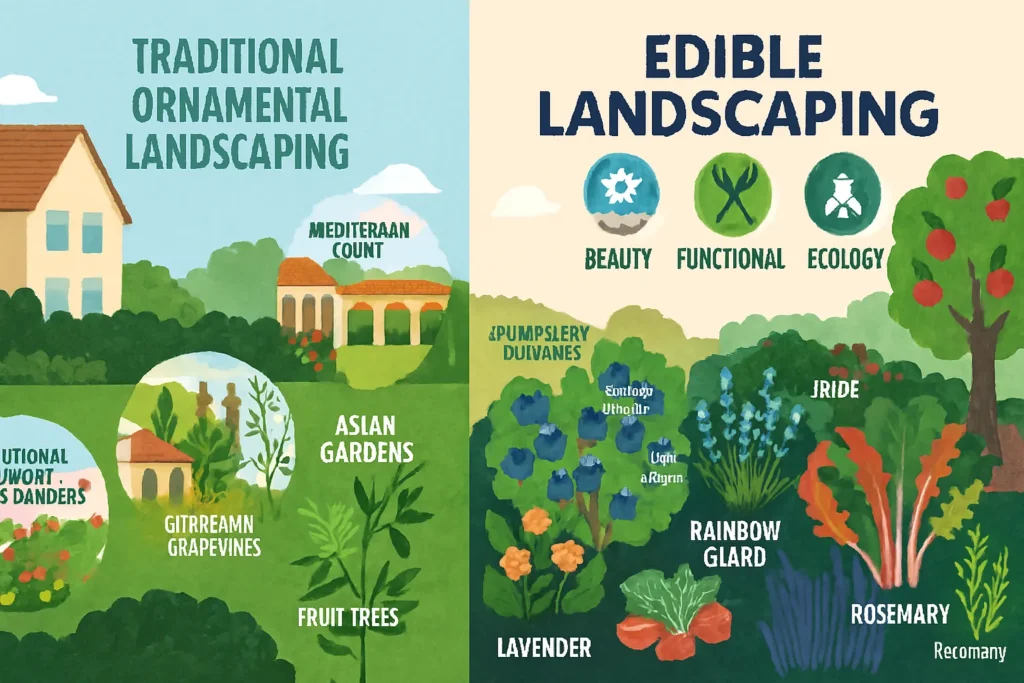
Most home gardeners dream of a space that’s both beautiful and useful. Imagine a garden where your flower beds are lined with herbs, your hedges are made of berry bushes, and fruit trees frame your patio. This is the essence of Edible & Functional Landscapes—gardens that nourish the body while delighting the eye.
For beginner and intermediate gardeners, the idea of combining design with food production can feel overwhelming. But here’s the good news: with the right edible landscaping ideas, you can transform any space—whether it’s a balcony, a suburban yard, or a community plot—into a thriving, edible paradise.
This guide will walk you through the principles of edible garden design, share creative landscaping ideas, and give you practical tips to make your garden both stunning and sustainable.
What is Edible Landscaping?
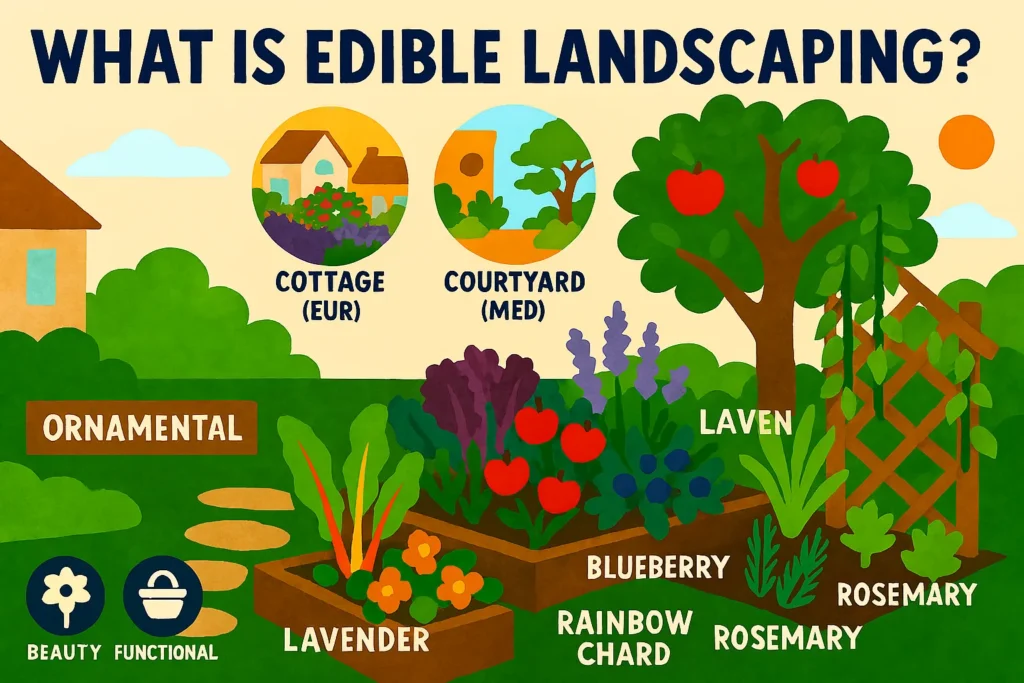
Edible landscaping is the art of designing gardens that integrate food-producing plants into ornamental spaces. Instead of hiding vegetables in a separate patch, you blend them with flowers, shrubs, and trees to create a cohesive, multifunctional landscape.
A Brief History
- Cottage gardens in Europe traditionally combined herbs, vegetables, and flowers in a single space.
- Mediterranean courtyards often featured citrus trees, grapevines, and herbs alongside ornamentals.
- Asian gardens integrated tea plants, bamboo, and fruit trees into serene landscapes.
Today’s edible landscaping draws inspiration from these traditions while adding modern design principles.
Why It Works
- Beauty: Many edible plants are naturally ornamental (think purple basil, rainbow chard, or blueberry bushes).
- Functionality: You harvest fresh produce right outside your door.
- Ecology: Edible plants attract pollinators, improve soil health, and reduce reliance on store-bought food.
Principles of Edible & Functional Landscapes
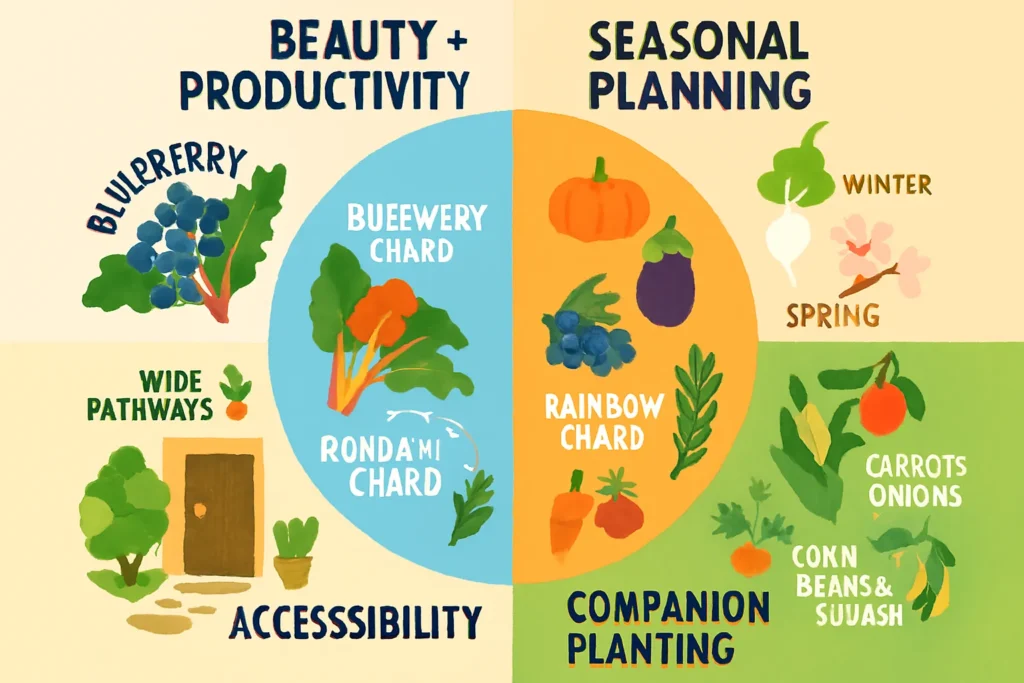
Before diving into specific ideas, it’s important to understand the principles that make edible landscapes thrive.
1. Blend Aesthetics with Productivity
Choose plants that look good and taste good. For example:
- Blueberries: spring blossoms, summer fruit, fall foliage.
- Rosemary: evergreen structure, fragrance, and culinary use.
- Chard: colorful stems that rival ornamental flowers.
2. Seasonal Planning
Design for year-round interest:
- Spring: blossoms from fruit trees, early greens.
- Summer: vibrant vegetables, herbs, and flowers.
- Autumn: colorful foliage, pumpkins, and root crops.
- Winter: evergreens, kale, and structural elements.
3. Companion Planting
Pair plants that support each other’s growth:
- Tomatoes + Basil: basil repels pests and enhances flavor.
- Carrots + Onions: onions deter carrot flies.
- Corn + Beans + Squash: the “Three Sisters” method.
4. Accessibility and Functionality
- Place herbs near the kitchen for easy harvesting.
- Use raised beds for better soil control and less bending.
- Design wide pathways for wheelbarrows and easy access.
Common Mistakes to Avoid
- Planting too much at once (overwhelm).
- Ignoring soil health.
- Forgetting about aesthetics (leading to a “messy” look).
Creative Edible Landscaping Ideas 🌱
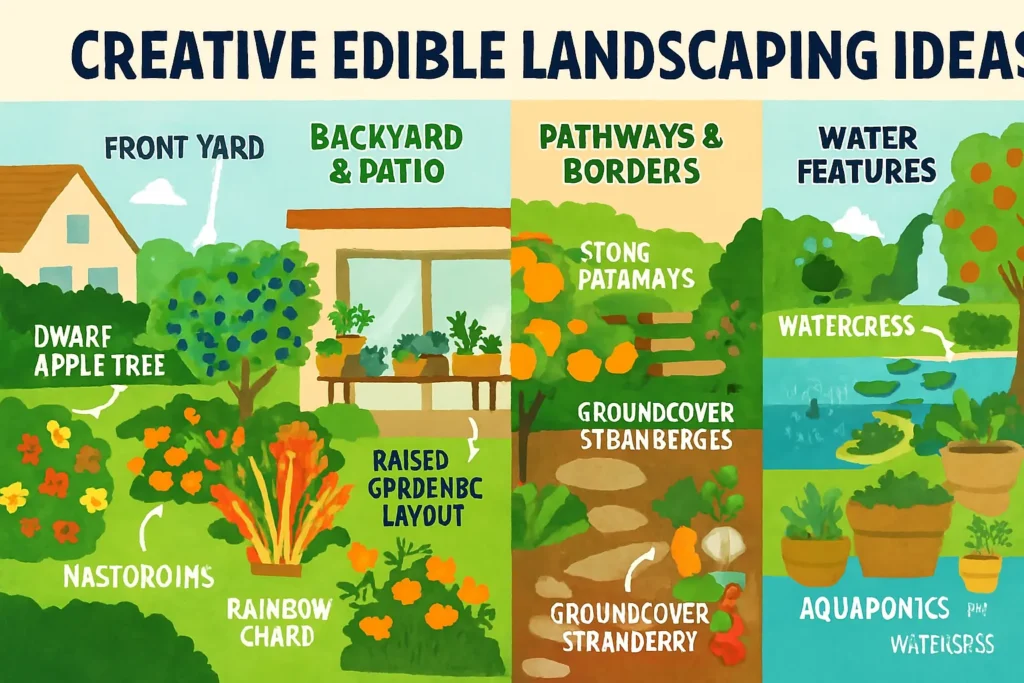
When most people think of landscaping, they picture manicured lawns, ornamental shrubs, and flower beds that are purely decorative. But what if every corner of your garden could be both beautiful and delicious? That’s the promise of edible landscaping—a design approach that transforms ordinary yards into vibrant, productive spaces.
In this section, we’ll explore a variety of edible landscaping ideas that work for different spaces: front yards, backyards, patios, pathways, and even water features. Whether you have a sprawling suburban lot or a small balcony, you’ll find inspiration to create an edible & functional landscape that’s as stunning as it is practical.
1. Front Yard Edible Landscaping Ideas
Your front yard is the first impression your home makes, so why not make it both welcoming and nourishing? With thoughtful edible garden design, you can replace traditional ornamentals with plants that provide food and beauty.
Fruit Trees as Focal Points
Instead of planting a purely ornamental tree, consider a dwarf apple, pear, or citrus tree. These trees provide spring blossoms, summer shade, and autumn harvests—all while looking just as attractive as a flowering cherry or maple.
- Beginner-friendly picks: Dwarf apple, fig, or lemon trees.
- Design tip: Plant them in symmetrical pairs along a walkway or as a centerpiece in a circular bed.
Berry Hedges
Why settle for boxwood when you can have blueberries or currants forming your hedge? Berry bushes are compact, colorful, and productive.
- Blueberries: Provide spring flowers, summer fruit, and brilliant fall foliage.
- Raspberries/Blackberries: Great for informal hedges, though they need pruning.
- Currants/Gooseberries: Shade-tolerant and perfect for smaller spaces.
Ornamental Vegetables
Vegetables don’t have to be hidden away in the backyard. Many are striking enough to take center stage.
- Rainbow chard: Bright stems in red, yellow, and orange.
- Purple kale: Adds texture and deep color.
- Red lettuce: Works beautifully as a border plant.
💡 Pro Tip: Mix in edible flowers like nasturtiums or calendula for extra color and pollinator support.
2. Backyard & Patio Edible Garden Design
The backyard is often where gardeners feel free to experiment. Here, you can combine structure with abundance, creating a space that’s both functional and inviting.
Raised Beds with Geometric Layouts
Raised beds are practical for growing vegetables, but they can also be designed to look elegant.
- Square or rectangular beds: Classic and easy to maintain.
- Circular or keyhole beds: Add visual interest and maximize planting space.
- Materials: Use cedar, stone, or even painted metal for a polished look.
💡 Design idea: Arrange four raised beds in a cross shape with a central focal point (like a birdbath or herb spiral).
Vertical Gardens
Vertical gardening is perfect for small backyards or patios. Trellises, arbors, and wall planters allow you to grow upward instead of outward.
- Climbers: Beans, cucumbers, peas, and passionfruit.
- Privacy screens: Grapevines or kiwi vines can cover fences or pergolas.
- Wall planters: Herbs like thyme, oregano, and parsley thrive in vertical pockets.
👉 If you’re curious about soil-free growing, try: How to Grow Tomatoes in Pots Without Soil
Container Gardening
Containers are versatile, mobile, and ideal for patios or balconies.
- Herbs: Basil, mint, rosemary, and chives.
- Dwarf fruit trees: Citrus, figs, or even pomegranates.
- Salad greens: Lettuce, arugula, and spinach grow quickly in pots.
💡 Visual trick: Use matching containers or coordinated colors to create a cohesive design.
3. Functional Pathways & Borders
Pathways and borders are often overlooked, but they’re prime real estate for edible plants.
Herb-Lined Walkways
Imagine brushing past rosemary or lavender as you walk through your garden. Herbs not only smell wonderful but are also easy to harvest.
- Best picks: Thyme, oregano, chives, and creeping rosemary.
- Design tip: Plant low-growing herbs along stepping stones for a natural, fragrant carpet.
Edible Groundcovers
Groundcovers prevent weeds, retain moisture, and add beauty. Why not make them edible, too?
- Creeping thyme: Fragrant and drought-tolerant.
- Oregano: Hardy and flavorful.
- Alpine strawberries: Produce small, sweet berries while covering the soil.
Edible Flowers
Flowers can be more than just eye candy. Many are edible and add flair to salads, desserts, and drinks.
- Nasturtiums: Peppery flavor, vibrant colors.
- Pansies and violas: Mild taste, perfect for garnishes.
- Calendula: Adds a saffron-like color to dishes.
- For a charming, layered aesthetic, explore cottage-style pairings: Cottagecore Plants for a Dreamy Garden Aesthetic
4. Water Features & Edible Integration
Water elements bring tranquility to a garden, but they can also be productive.
Pond Edges with Watercress
Watercress thrives in moist conditions and adds a lush, green border to ponds or water features. It’s also packed with nutrients.
Aquaponics Systems
For the adventurous gardener, aquaponics combines fish tanks with vegetable beds. The fish provide nutrients for the plants, and the plants filter the water for the fish.
- Beginner-friendly crops: Lettuce, basil, and water spinach.
- Fish options: Tilapia, koi, or goldfish.
Decorative Planters Near Water Features
Large pots filled with leafy greens or herbs can soften the edges of fountains or ponds. The reflection of greenery in the water adds depth and beauty.
5. Bringing It All Together
The beauty of edible landscaping ideas is that they can be scaled to fit any space. A small balcony can host a vertical herb garden, while a large backyard can be transformed into a mini food forest. The key is to think creatively and design with both form and function in mind.
- For beginners: Start with one element—like a herb-lined pathway or a container of strawberries.
- For intermediate gardeners: Experiment with layering—fruit trees, berry shrubs, herbs, and groundcovers all working together.
- For design enthusiasts: Play with symmetry, color, and texture to create a garden that looks intentional and artistic.
Designing for Beauty & Abundance
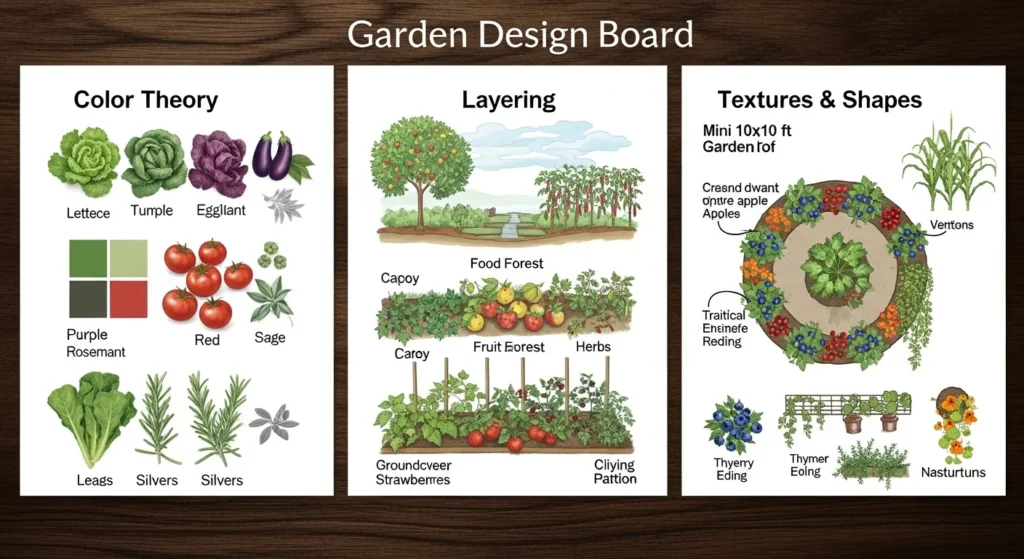
A successful edible garden design balances form and function. Here’s how to make your garden look intentional, not accidental.
Color theory in the garden
- Greens: lettuce, kale, spinach.
- Purples: eggplant, purple basil, red cabbage.
- Reds/oranges: tomatoes, peppers, rainbow chard.
- Silvers/grays: sage, lavender, artichokes.
Mixing these colors creates contrast and visual drama. For inspiration on soft, romantic palettes that still feel abundant, see: Cottagecore Plants for a Dreamy Garden Aesthetic
Layering for depth
Think of your garden as a natural “food forest”:
- Canopy layer: fruit trees (apple, pear, citrus).
- Shrub layer: berries (blueberries, currants).
- Herbaceous layer: herbs and vegetables.
- Groundcover: strawberries, thyme.
- Vertical layer: climbing beans, grapes.
Textures and shapes
- Combine leafy greens with spiky herbs.
- Use trailing plants (like nasturtiums) to soften edges.
- Add vertical accents with trellises or tall corn stalks.
💡 Mini design exercise: Imagine a 10×10 ft garden. Place a dwarf apple tree in the center, surround it with blueberry shrubs, edge the bed with thyme, and let nasturtiums trail over the sides. You’ve just created a layered, edible landscape that looks like a designer’s dream.
Practical Tips for Success
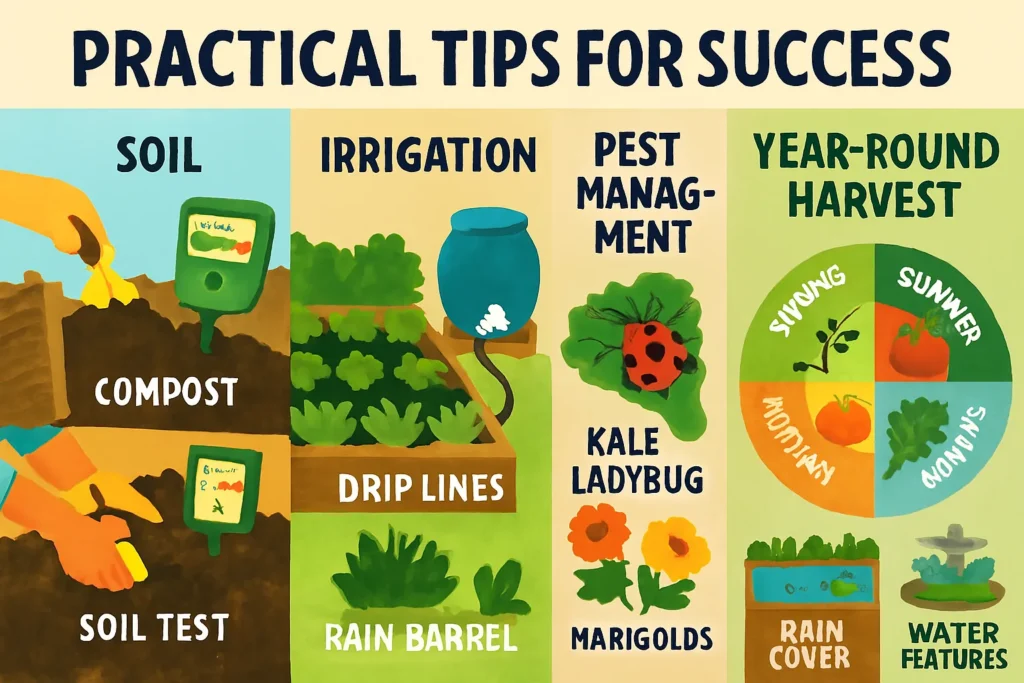
Soil preparation
Healthy soil is the foundation of any edible landscape.
- Add compost and organic matter annually. Upcycle Smart: How I Turned Trash Into Garden Treasure (great for repurposing containers and materials).
- Try nutrient “hot spots” for heavy feeders: What’s a Melon Pit? Optimize Your Garden & Boost Produce
- Test soil pH and adjust for specific crops. Local extension resources are helpful: University of Minnesota Extension: Soil Testing.
- Mulch to retain moisture and suppress weeds.
Irrigation systems
Watering can make or break your garden.
- Drip irrigation: efficient and reduces disease.
- Soaker hoses: easy to install and water evenly.
- Rain barrels: sustainable and cost-effective; learn more about water-wise gardening via EPA WaterSense Outdoor.
Pest management
Skip the harsh chemicals and work with nature.
- Plant marigolds, dill, and yarrow to attract beneficial insects.
- Encourage ladybugs and lacewings (beneficials love diverse plantings).
- Use row covers for vulnerable crops.
- For practical, non-toxic strategies, scan UC IPM: Home & Garden.
Year-round harvest planning
- Spring: peas, spinach, radishes.
- Summer: tomatoes, peppers, cucumbers.
- Fall: kale, carrots, beets.
- Winter: garlic, leeks, hardy greens.
Pro tip: Stagger plantings every 2–3 weeks for continuous harvests. Choose varieties that fit your climate—check the USDA Plant Hardiness Zone Map to fine-tune your planting windows.
Bonus: mindset for sustainable momentum
Embrace low-stress, restorative routines: Slow Gardening: Rest & Reconnect.
Keep projects bite-sized and repeatable (one bed, one trellis, one habit at a time).
Inspiring Examples of Edible & Functional Landscapes
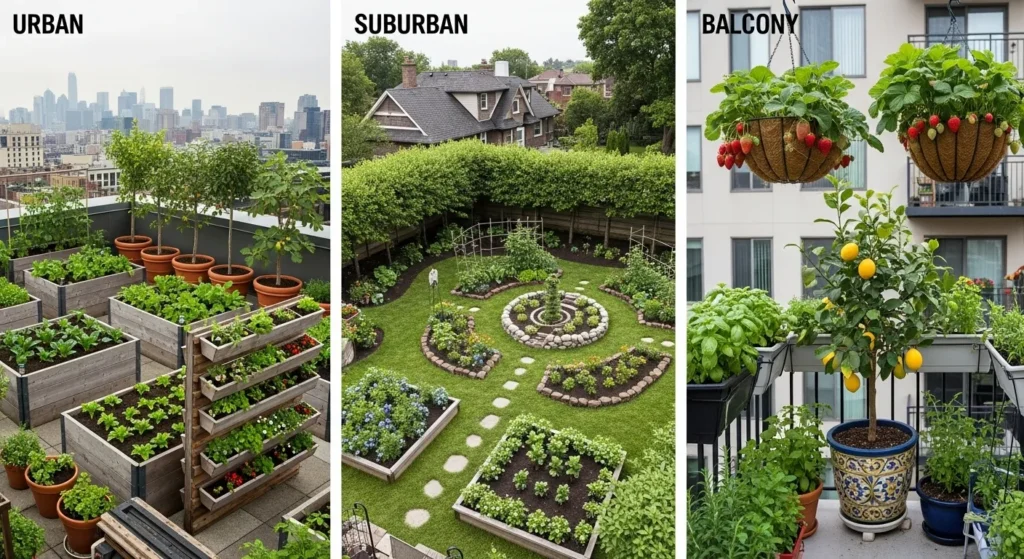
Urban rooftops
Raised beds, vertical gardens, and container fruit trees turn rooftops into productive oases. Imagine sipping coffee surrounded by grapevines and basil pots. Use modular beds, lightweight potting mixes, and integrated drip lines to simplify maintenance.
Suburban yards
Replace lawns with fruit trees, herb spirals, and pollinator-friendly flowers. A front yard with blueberry hedges and a backyard with raised beds can feed a family year-round. For design bravery, borrow ideas from creative features like living mazes and structured hedges: Martha Stewart’s Living Garden Maze: How To Make Your Own
Small balconies
Even the tiniest space can be productive. Hanging baskets with strawberries, railing planters with herbs, and dwarf citrus in pots create a lush retreat. If you’re space-limited or curious to experiment, try soil-free setups for compact crops: Grow Tomatoes in Pots Without Soil
Case study: A 10×10 ft balcony was transformed with vertical planters, dwarf lemon trees, and salad greens in containers—yielding fresh produce for a family of four.
FAQs about edible landscaping
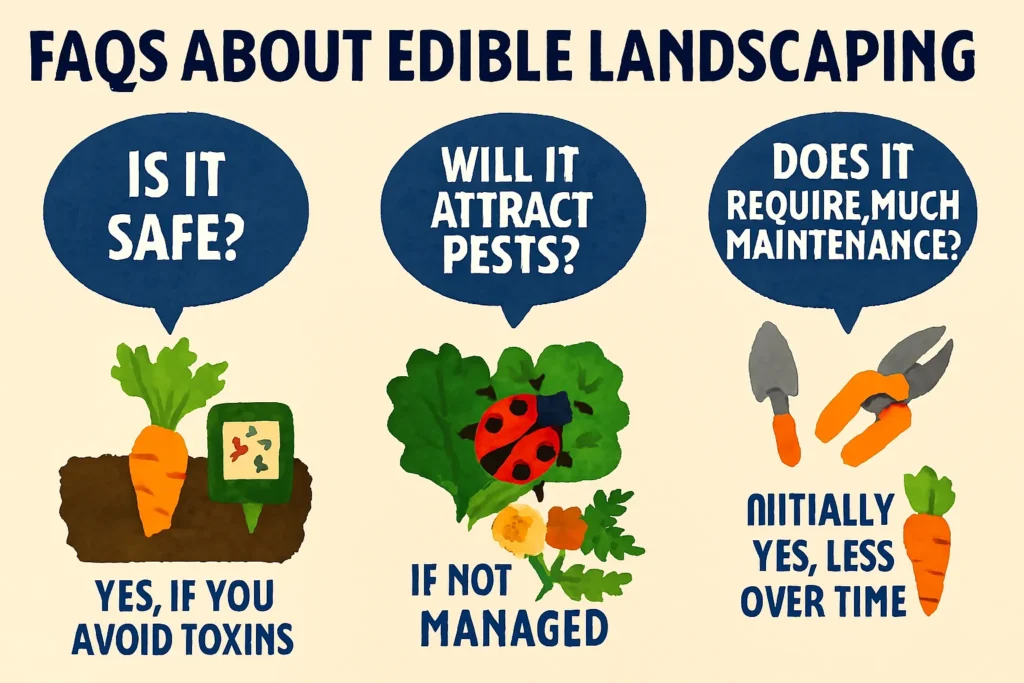
Q: What are the easiest plants for edible landscaping?
A: Herbs (basil, mint, rosemary), leafy greens (lettuce, kale), and berry bushes are beginner-friendly. If you’re using raised beds, start with these: Best Vegetables for Raised Beds.
Q: Can edible landscaping work in small spaces?
A: Absolutely! Vertical gardens, containers, and compact fruit trees make it possible even on balconies. For ideas and structure, try a simple build: Beginner’s Guide to DIY Raised Garden Beds.
Q: Do edible landscapes require more maintenance? A:
Not necessarily. With good design—mulching, drip irrigation, perennial anchors—they can be low-maintenance. Practice “slow gardening” to reduce stress: Slow Gardening.
Q: How do I keep my edible landscape looking neat?
A: Use symmetry, repeat plant colors, and edge beds with low-growing herbs. Keep structures consistent (matching trellises, coordinated containers).
Q: What’s the best way to start if I only have 1 hour a week?
A: Begin with a container herb garden or a single raised bed. Choose safe materials and a simple layout: Safe Materials for Raised Beds.
Q: Can edible landscaping increase property value?
A: Yes—well-designed edible landscapes are attractive, sustainable, and increasingly desirable to buyers. Focus on neat edges, clear structure, and plant choices that offer four-season interest.
Q: Which flowers help support pollinators in edible landscapes?
A: Calendula, borage, nasturtium, thyme, lavender, echinacea. For deeper pollinator-friendly planting, the Xerces Society has excellent regional resources.
Q: Where can I learn more about plant companions and spacing?
A: The RHS Companion Planting guidance and your local extension’s vegetable guides are great places to start.
Conclusion: Your Garden, Your Living Pantry
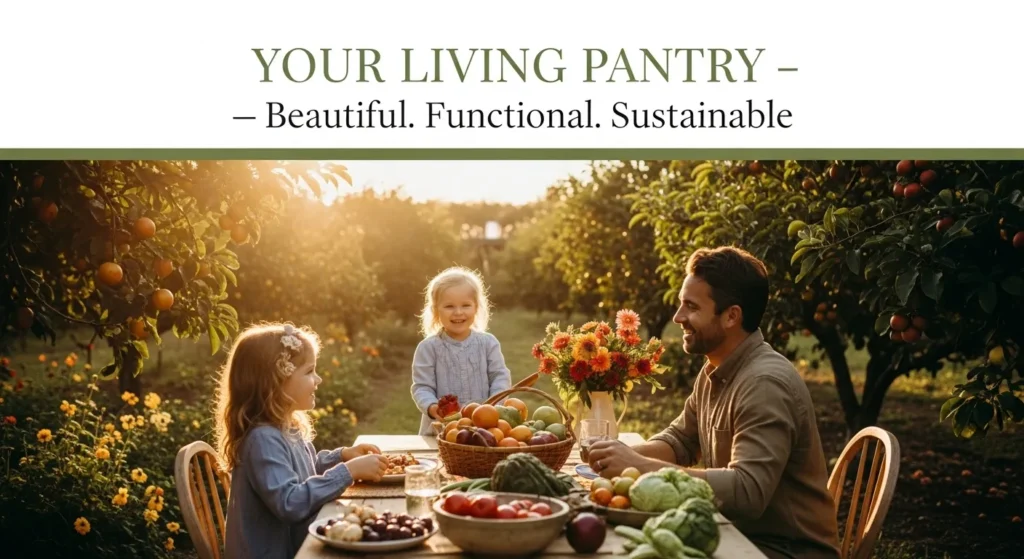
Edible landscaping ideas are more than just a gardening trend—they’re a way to live more sustainably, eat healthier, and enjoy a garden that’s as beautiful as it is functional. By embracing edible & functional landscapes, you can create a space that nourishes your body, supports pollinators, and delights the senses.
Whether you’re starting with a few herb pots on a balcony or redesigning your entire yard, thoughtful edible garden design ensures your outdoor space works harder for you.
So, why settle for a garden that only looks good when it can also feed you? Start small, experiment, and watch your landscape transform into a living pantry that’s both stunning and sustainable.

